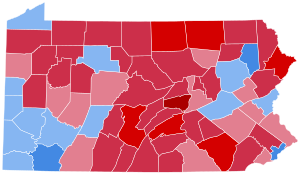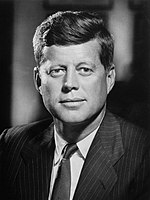| ||||||||||||||||||||||||||
| ||||||||||||||||||||||||||
 County Results
| ||||||||||||||||||||||||||
| ||||||||||||||||||||||||||
| Elections in Pennsylvania |
|---|
 |
|
|
The 1960 United States presidential election in Pennsylvania took place on November 8, 1960 as part of the 1960 United States presidential election. Voters chose 32 representatives, or electors to the Electoral College, who voted for president and vice president.
Pennsylvania had historically been a powerfully Republican state that owing to the industrialization had become Democratic-leaning following the New Deal:[1] 1960 saw Democrats surpass Republicans in registration for the first time since the Civil War.[2] However, the nomination of the second Catholic presidential candidate in John F. Kennedy complicated this issue because most of rural Pennsylvania was powerfully Protestant and extremely hostile to voting for a Catholic,[3] creating the potential for large anti-Democratic swings and trends in the northeastern non-Yankee Pocono Mountains. The Pennsylvania Dutch Country had been similarly hostile to Catholicism throughout the state’s history,[4] and, owing to the opposition to Irish control of the Democratic Party, most of the state’s urban Catholics would, before the New Deal, back dominant Republican machines in which they had no actual political power.[5]
However, in 1958 Pennsylvania – a state historically very reluctant to elect Catholics to major offices – had elected David L. Lawrence as governor. Nevertheless, his margin was much smaller than polls had previously predicted, with decreases vis-à-vis the 1954 gubernatorial election even in heavily Catholic urban counties.[6] Kennedy had emerged as the front-runner for the Democratic nomination but Pennsylvania Democrats were reluctant to run him for fear of an anti-Catholic reaction in traditionally Democratic rural counties. However, lobbying by Boston Archbishop Richard Cushing meant Governor Lawrence released 64 of the state’s 81 delegates for Kennedy[7] in a bid to stop Adlai Stevenson II from gaining a third nomination.[8]
Pennsylvania narrowly voted for Kennedy over the Republican nominee, Vice President Richard Nixon. Kennedy won Pennsylvania by a slim margin of 2.32%, being aided rather than hindered by his Catholic faith owing to the numerical power of his co-religionists in urban Philadelphia, Lackawanna County, and in the industrial areas around Lake Erie.[6] This clearly outnumbered anti-Catholic sentiment in rural areas, which caused him to lose ground vis-à-vis Adlai Stevenson in 16 rural counties.[6] Kennedy became the first Democrat ever to win the White House without York County and the second to win without Columbia County and Berks County.
- ^ See Phillips, Kevin P.; The Emerging Republican Majority, p. 135 ISBN 978-0-691-16324-6
- ^ Kennedy, John J.; Pennsylvania Elections, p. 191 ISBN 0761864431
- ^ Menendez, Albert J.; The Religious Factor in the 1960 Presidential Election: An Analysis of the Kennedy Victory Over Anti-Catholic Prejudice, pp. 193, 196 ISBN 0786484934
- ^ Menendez, The Religious Factor in the 1960 Presidential Election, p. 195
- ^ Phillips; The Emerging Republican Majority, p. 34
- ^ a b c McKenna, William J.; ‘The Influence of Religion in the Pennsylvania Elections of 1958 and 1960’; Pennsylvania History: A Journal of Mid-Atlantic Studies, vol. 29, no. 4 (October, 1962), pp. 407-419
- ^ Carty, Thomas; A Catholic in the White House?: Religion, Politics, and John F. Kennedy’s Presidential Campaign, p. 102 ISBN 1403981302
- ^ Donaldson, Gary; The First Modern Campaign: Kennedy, Nixon, and the Election of 1960, p. 75 ISBN 0742548007

